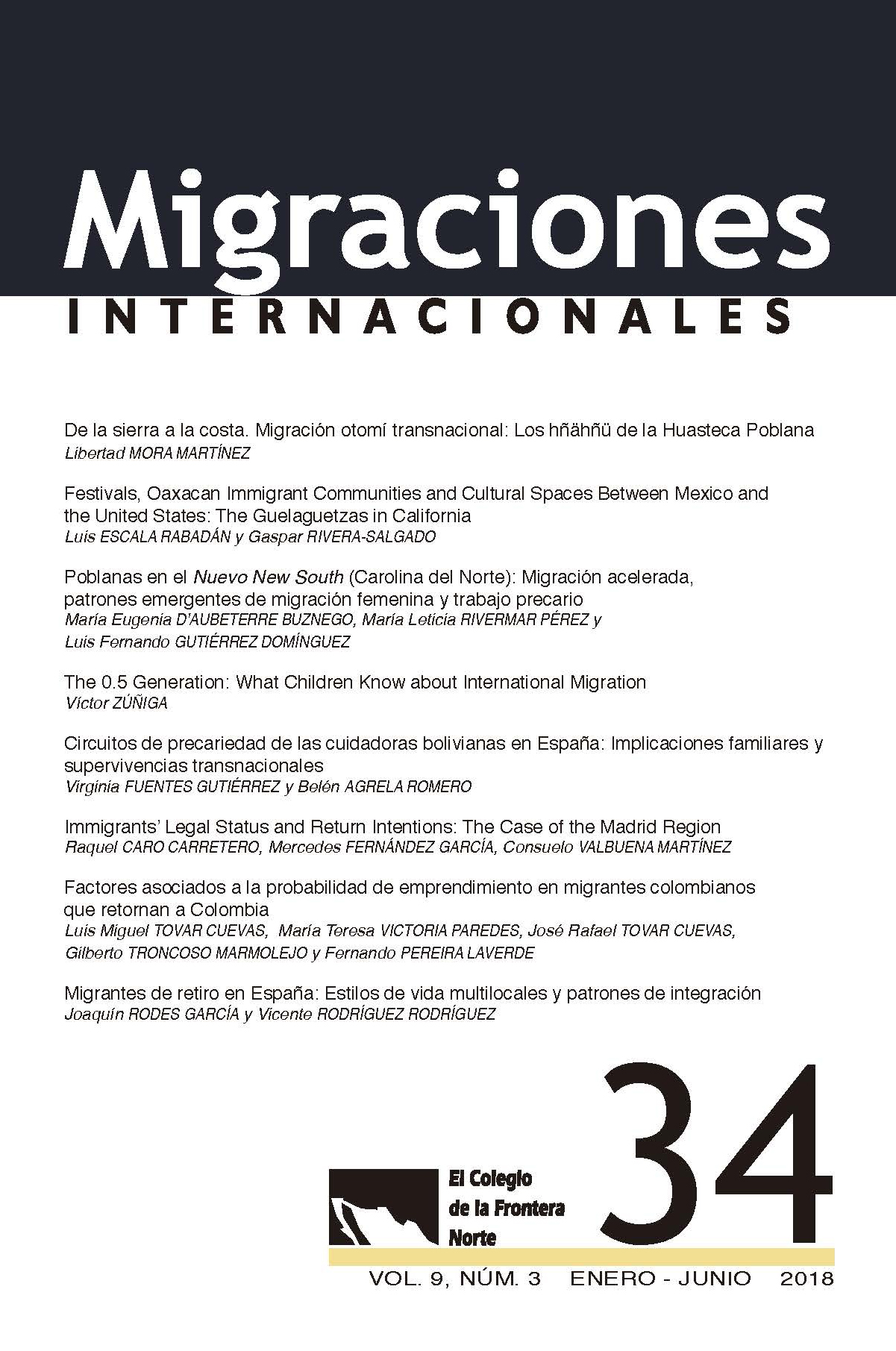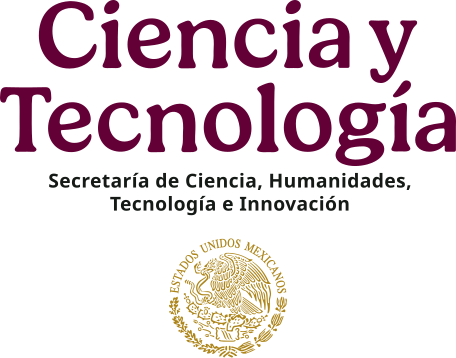The 0.5 Generation: What Children Know about International Migration
DOI:
https://doi.org/10.17428/rmi.v9i34.334Keywords:
Mexico/U.S. migration, migrant children, deportation, national affiliations, return migration.Abstract
This paper presents an analysis of 179 interviews with children who lived in the United States and then returned to Mexico following various itineraries. This article seeks to discover the knowledge children accumulate about international migration—i.e., what do they know about migration? All the interviewed children received part of their education in the United States; that is why this article classifies them as members of the 0.5 generation. This definition allows the formulation of the question in a clearer manner: What knowledge of everyday life have children developed about international migration movements?References
Batalova, J. (2008). Mexican Immigrants in the United States. Washington, D. C.: Migration Policy Institute.
Batalova, J. & Fix, M. (2010). Children of Immigrants in US Schools: A Portrait. Washington, D. C.: Migration Policy Institute Center/ National Center on Immigrant Integration Policy.
Boehm, D. A., Hess, J. M., Coe, C., Rae-Espinoza, H., & Reynolds, R. R. (2011). Introduction: Children, Youth, and the Everyday Ruptures of Migration. In C. Coe, R. R. Reynolds, D. A. Boehm, J. M. Hess, & H. Rae-Espinoza. (Eds.), Everyday Ruptures: Children, Youth and Migration in Global Perspective (pp. 1-19). Nashville, TN: Vanderbilt University Press.
Bunnell, T., Yea, S. Peake, L., Skelton, T., & Smith, M. (2012). Geographies of friendships. Progress in Human Geography, 36(4), 490-507.
Coe, C. (2011). How Children Feel about Their Parents’ Migration: A History of the Reciprocity of Care in Ghana. In C. Coe, R. R. Reynolds, D. A. Boehm, J. M. Hess, & H. Rae-Espinoza. (Eds.), Everyday Ruptures: Children, Youth and Migration in Global Perspective (pp. 97-114). Nashville, TN: Vanderbilt University Press.
Coe, C. Reynolds, R. R., Boehm, D. A. Hess, J. M., & Rae-Espinoza, H. (Eds.). (2011). Everyday Ruptures: Children, Youth and Migration in Global Perspective. Nashville, TN: Vanderbilt University Press.
Dobson, M. E. (2009). Unpacking Children in Migration Research. Children’s Geographies, 7(3), 355-360.
Dreby, J. (2010). Divided by Borders: Mexican Migrants and their Children. Berkeley: University of California Press.
Durand, J., Massey, D. S., & Zenteno, R. M. (2001). Mexican immigration to the United States: Continuities and changes. Latin American Research Review, 36(1), 107-127.
Ensor, M. O., & Gozdziak, E. M. (2010). (Eds.). Children and Migration: At the Crossroads of Resiliency and Vulnerability. New York: Palgrave Macmillan.
Escobar Latapí, A., Lowell, L., & Martin, S. (Eds.) (2013). Binational Dialogue on Mexican Migrants in the U.S. and Mexico: Final report. Washington, D.C.: CIESAS, Georgetown University.
Farley, R. & Alba, R. (2002). The new second generation in the United States. International Migration Review, 36(3), 669-701.
Fass, P. S. (2007). Children of a New World, Society, Culture, and Globalization. New York: New York University Press.
Giorguli, S. E. & Gutiérrez, E. Y. (2011). Niños y jóvenes en el contexto de la migración internacional entre México y Estados Unidos. Coyuntura Demográfica. Revista sobre los procesos demográficos en México hoy, 1, 21-25.
Gonzales, R. G. (2011). Learning to be Illegal: Undocumented Youth and Shifting Legal Contexts in the Transition to Adulthood. American Sociological Review, 76(4), 602-619.
Hamann, E. T. (2001). Theorizing the Sojourner Student (With a Sketch of Appropriate School Responsiveness). In M. Hopkins, and N. Wellmeier. (Eds.), Negotiating Transnationalism: Selected Papers on Refugees and Immigrants (Vol. 9, pp. 32-71). Arlington, TX: American Anthropological Association
Hamann, E. T., & Zúñiga, V. (2011). Schooling and the Everyday Ruptures Transnational Children Encounter in the United States and Mexico. In C. Coe, R. R. Reynolds, D. A. Boehm, J. M. Hess, & H. Rae-Espinoza. (Eds.), Everyday Ruptures: Children, Youth and Migration in Global Perspective (pp. 141-160). Nashville, TN: Vanderbilt University Press.
Heller, A. (1977). Sociología de la vida cotidiana. Barcelona, Spain: Ediciones Península.
Hernández-León, R. & Zúñiga, V. (2003). Mexican Immigrant Communities in the South and Social Capital. Southern Rural Sociology, 19(1), 20-45.
Kasinitz, P., Mollenkopf, J. H., Waters, M. C., & Holdaway, J. (2008). Inheriting the City: The Children of Immigrants Come of Age. New York: Russell Sage Foundation.
Mancillas Bazán, C. (2010). Migración de menores mexicanos a Estados Unidos. In P. Leite and S. E. Giorguli. (Eds.), El estado de la migración. Las políticas públicas ante los retos de la migración mexicana a Estados Unidos (pp. 211 246). Mexico City: Conapo.
Ní Laoire, C., White, A., Tyrrel, N., & Carpena-Méndez, F. (2012). Children and Young People on the Move: Geographies of Child and Youth Migration. Geography, 97(3), 129-134.
Inter-American Commission on Human Rights. (2013). El derecho del niño y la niña a la familia. Cuidado alternativo. Poniendo fin a la institucionalización en las Américas. Organization of American States/Inter-American Commission on Human Rights/Unicef. Retrieved from http://www.oas.org/es/cidh/infancia/docs/pdf/informe-derecho-nino-a-familia.pdf
Orellana, M. F., Thorne, B., Chee, A., & Eva Lam, W. S. (2001). Transnational Childhoods: The Participation of Children in Processes of Family Migration. Social Problems 48(4), 572-591.
Panait, C. (2011). Cuentos de mis escuelitas: La princesa y el hombre de hojalata. Transiciones, rupturas e identidades lingüísticas en alumnos con escolaridad circular (Master’s thesis). Monterrey, Mexico: Universidad de Monterrey.
Parreñas Salazar, R. (2005). Children of Global Migration: Transnational Families and Gendered Woes. Stanford, CA: Stanford University Press.
Portes, A. (1996). The New Second Generation. New York: Russell Sage Foundation.
Portes, A. & Rumbaut, R. G. (2001). Legacies: The Story of the Immigrant Second Generation. Berkeley: University of California Press.
Quiroz, P. A. (2001). The Silencing of Latino Student “Voice”: Puerto Rican and Mexican Narratives in Eighth Grade and High School. Anthropology & Education Quarterly, 32(3), 326-349.
Reese, L. (2002). Parental Strategies in Contrasting Cultural Settings: Families in México and “El Norte.” Anthropology & Education Quarterly, 33(1), 30-59.
Rendall, M. S. & Torr, B. M. (2008). Emigration and Schooling among Second-Generation Mexican-American Children. International Migration Review, 42(3), 729 738.
Rumbaut, R. G. (2004). The Crucible within: Ethnic Identity, Self-Esteem, and Segmented Assimilation Among Children of Immigrants. International Migration Review, 28(4), 748-794.
Rumbaut, R. G. & Portes, A. (Eds.) (2001). Ethnicities: Children of Immigrants in America. Berkeley: University of California Press.
Shepler, S. (2011). Transnational Fosterage: The Novel Care Arrangements between Guinean Caregivers and Ivorian and Liberian Children Fleeing War. In C. Coe, R. R. Reynolds, D. A. Boehm, J. M. Hess, & H. Rae-Espinoza. (Eds.), Everyday Ruptures: Children, Youth and Migration in Global Perspective (pp. 63-78), Nashville, TN: Vanderbilt University Press.
Smith, M. P. (1994). Can You Imagine? Transnational Migration and the Globalization of Grassroots Politics. Social Text, 39, 15-33.
Suárez-Orozco, C. & Suárez-Orozco, M. (2002). Children of Immigration. Cambridge, MA: Harvard University Press.
Valdés, G. (2003). Expanding Definitions of Giftedness: The Case of Young Interpreters from Immigrant Communities. Mahwah, NJ: Laurence Erlbaum Associates Publishers.
Vandeyar, S. & Vandeyar, T. (2011). The Constitution, Negotiation, and Representation of Immigrant Student Identities in South African Schools. In S. Vandeyar. (Ed.), Hyphenated Selves: Immigrant Identities within Education Contexts (pp. 9-30). Amsterdam: Rozenberg Publishers.
Villaseñor, B. & Moreno, J. (Eds.) (2006). La esperanza truncada. Menores deportados por la garita Mexicali-Caléxico. Mexico City: Albergue del Desierto, Sedesol, Sedesoe.
Willis, K. & Yeoh, B. S. A. (2000). Gender and transnational household strategies: Singaporean Migration to China. Regional Studies, 34(3), 253-264.
Zúñiga, V. (2015). Niños y adolescentes separados de sus familias por la migración internacional: el caso de cuatro estados de México. Estudios Sociológicos, 33(97), 145-168.
Zúñiga, V. & Hamann, E. T. (2015). Going to a home you have never been to: the return migration of Mexican and American-Mexican children. Children’s Geographies, 13(6), 643-655.
Published
Issue
Section
License
Authors publishing work in this journal agree to the following conditions:
Authors retain copyright and assign first publication rights to the journal Migraciones Internacionales (MI), with the texts registered under an Attribution-NonCommercial-NoDerivatives 4.0 International Creative Commons license (CC BY-NC-ND 4.0), which allows third parties to use published material provided they give credit to the authors and acknowledge this journal as the first publisher.
They authorize the reproduction, publication, translation, communication, and transmission of their paper and all accompanying material, publicly and in any form and by any means; its public distribution in as many copies as required; and public communication thereof in any form, including making it available to the public through electronic means or any other technology, and solely for dissemination and scientific, cultural, and non-commercial purposes.
Authors may enter into further independent contractual agreements for the non-exclusive distribution of the version of the paper published in this journal (for instance, to include it in an institutional repository or personal webpage, or publish it in a book), provided it is not for commercial purposes and they clearly state that the work was first published in Migraciones Internacionales (MI) [and add the corresponding bibliographical record: Author/s (Year). Title of paper. Migraciones Internacionales, volume (number), pp. doi: xxxx].
To that end, authors must submit the form assigning ownership of first publication rights, duly completed and signed. This document is to be uploaded in PDF format as a complementary file on the OJS platform.
This work is released under an Attribution-NonCommercial-NoDerivatives 4.0 International Creative Commons license (CC BY-NC-ND 4.0)..



 Language
Language










